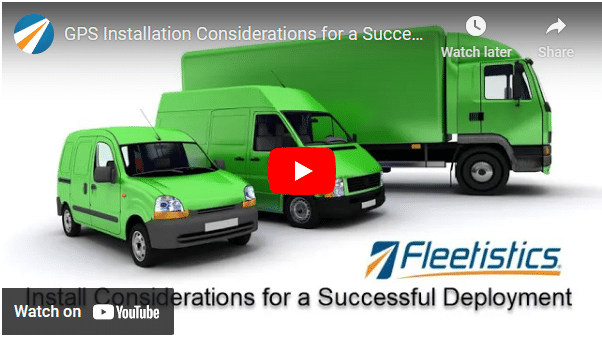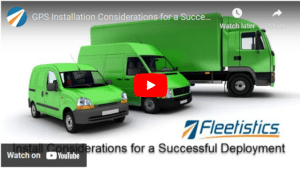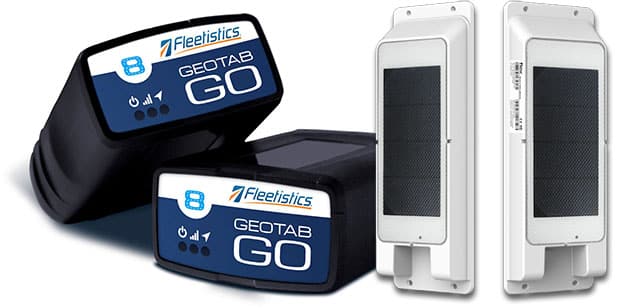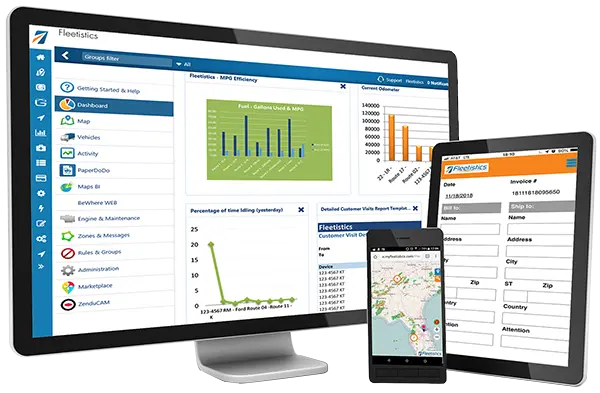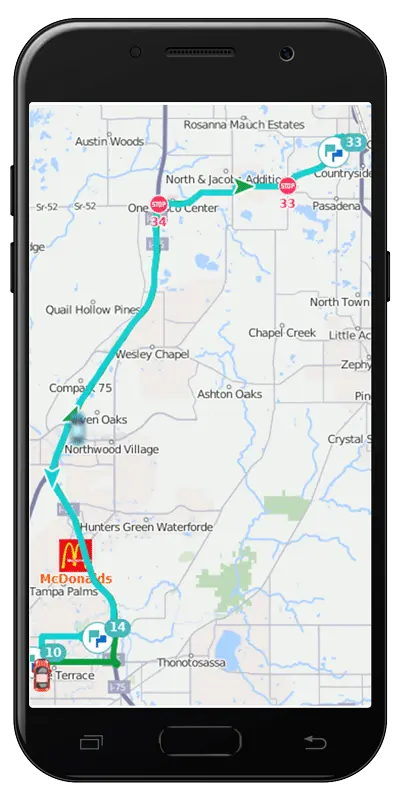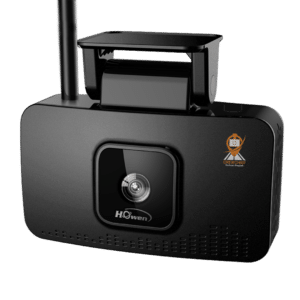Eron Iler, CEO of Fleetistics,
discusses how to plan and execute a successful deployment with Mitch Davis from GPS Nashville. If you are considering implementing GPS, dashcams or similar technology, this is a must-see interview!
Transcript – Introducing our Hosts
Hi, everybody.
My name is Eron Iler and I am with Fleetistics, and today we are here with Mitch Davis who is from GPS Nashville. And today, we’re going to be talking about the installation of telematics, dash Cam and other technology that goes into fleets.
Mitch is an expert and has been doing this quite a while. And we thought it would be interesting to bring Mitch to you to hear, you know, from an installer’s perspective, what are the things that you need to be thinking about as you get ready to tackle an installation project.
So, Mitch, tell us a little bit about yourself, how long you’ve been doing this? A little bit about your company and we’ll go just kind of roll from there.
Yeah. Thanks for having me. It’s a pleasure to be here and help share some information to help the process go a lot smoother.
I started with a call Fleet GPS installations background 2002. I worked in an area as a government contractor where we were installing GPS and different types of technologies on a very different scale and I was approached by a little tiny company back then called that just came out come over from Ireland called Fleetmatics.
I had a meeting with a gentleman from Fleetmatics at our local airport and he discussed their idea and their technology with me. And I said, well, you know, that’s all nice. And when I told him, he asked me how much I wanted to install a device, I threw a number at him. He almost fell out of his chair.
I said we’ve got to, you know, remember, you know, we’re putting these things in. We’re pulling tail lights out and we’re cutting holes and panels and we’re making things look like they’re not supposed to be there. It’s like there’s no trace of what we’re doing.
He said no, no, no, no, no. These are for plumbing companies and heating and air companies and whatnot. And I think the first year I installed maybe 5 devices and here we are in 2024 and now we’re up to, you know, thousands of devices, you know per year, not just GPS, but we’ve gotten into dash cameras, multi camera systems, tattletale systems for cargo sensors and cranes. And yeah, just working on everything and anything if it if it has an engine and wheels or tracks, more than likely we put something in and you know with the exception of aircraft. So it’s, it’s been an interesting ride that that tiny little company was bought out.
As time went on, we kept doing our usual thing, doing installs, working with customers, different products, new companies popped up and I think I guess around 2016 this little, tiny company went public or they went public a few years before that. And then this other company called Verizon popped up and bought this little company that I was working with Well, and they bought that little company.
They said keep doing what you’re doing, but get more people, get bigger. We like your style. We like your concept. Get more people and train them to do it the way you’re doing it. And we think it’ll be a home run. Well, it was.
And we listened to them, and you know, we grew with the company. And again, that that little, tiny company that just started, you know, you know less than 20 years later was purchased for $2.4 billion in cash. So you know, you know diligence and hard work you know will pay off knowing your business, knowing you’re you know staying in your lane and sticking with what you do best, it will definitely pay off.
So that’s where it all started.
The other portion of the business was – is an investigation company. We specialized in surveillance technology. So, we’re very acclimated with working with products you know that were you know DC voltage products and deploying products out in the field going where you couldn’t just plug something in or throw something up into a rack.
It was very, I came from a very different world that’s you know that has changed you know by the day since then. So, as you know I work with both technologies bringing everything together and you know we just ended up doing more automotive technology work and fleet safety work than anything.
So, you know here we are today, we’re in our 2020 first year going our 22nd year, you know working out just call an automotive fleet safety and we we’ve been in for a long haul. So that’s where we’re at today, right, right.
That brings up a couple memories of mine. I started Fleetistics 23 years ago and I used to have to do my own installs along with Technical Support, training, administration, and sales. You know, so I was like this one-man band and after I sold it and if they were nearby, I’d go out and do the installs too.
So, you know, I got my hands dirty there for a while. I quickly learned that’s not me, that’s, you know, I can do a lot of things, but doing that well was just not one of them. And then you talk about, you know, the covert space or some things like that.
I can remember doing a presentation for the Secret Service in Washington and walked up to a building, just a completely blank building. I had a laptop, and we were selling passive technology at the time. Real time technology wasn’t even out yet.
So, we went down into the basement of the garage underneath the facility and here I am standing with a laptop in my arm trying to make a 900-megahertz system function. And this was back when Geotab still had their software on CDs, right.
So, it was just this whole calamity of variables that was just never going to ever possibly work. But for some reason your comment just sparked that memory for me, you know, it’s interesting.
GPS Installation Considerations in Vehicles, Assets, and Equipment
So, let’s see. So, is there any type of vehicle that you haven’t worked on?
Aviation. Aviation is something that we’ll never work on just because you know, it’s a whole different discipline and set of rules, not too much green stuff. We’ve done installations for several agencies on their boats and that was more GPS tracking than anything just to show the location of these boats.
And there weren’t you know yachts or anything like that, just small, I guess small, small enforcement boats if you want to call it that or enforcement vessels. So, we’ve worked on those and that’s been pretty much it. But you know, again you know track, you know it has tracks, wheels, pulleys and engines and now electrics and hybrids we’ve you know we haven’t done all of it, but we’ve done a good fair share.
So, so most of our listeners are going to be fleet operators, they’re going to have vehicles, you know pickup trucks, cars, semis you know a tandem axle, those types of vehicles and then they’re going to have yellow iron forklifts and things like that. I’m assuming you worked with all those things.
Now, you mentioned yellow iron. Yeah, we kind of embraced yellow iron because it was a whole separate science all to itself. You know, from you know what are the owners looking forward to placement of devices on all iron machines and you know, learning about, you know, safety features and things that you can’t touch because of OSHA. So, it’s a whole yellow iron is a discipline.
It’s definitely not just a “We could just plug it in, and it’ll work” scenario, yeah.
With that, I notice you have an excavator on your table behind you.
Yeah, Cat 336 that we actually use it sometimes for demonstrations for things, you know, for rollover, demonstrating safety stuff with rollover protection systems and whatnot.
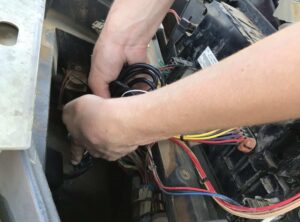
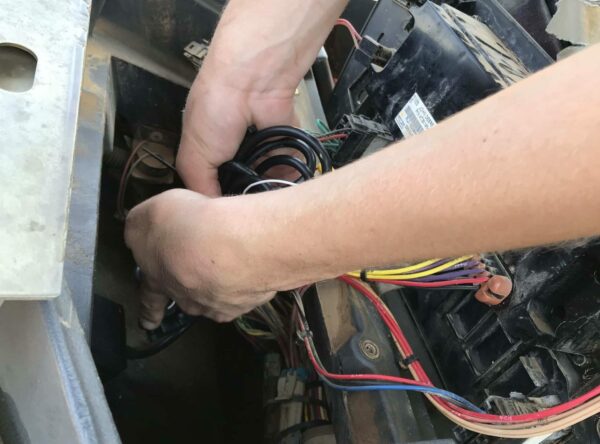
Hire a Professional for GPS Installaton, or Do it Yourself?
Well, let’s talk about what a fleet operator, manager, owner should be considering because often times that they think that they can do it themselves, right?
And sometimes they can.
You know, I was just at a customer’s location in Georgia, and they were paying for installs and I drove up and they had 15 bays of qualified mechanics working on every type of vehicle that they had. And you know we were wondering why are why would they outsource like service work, you know, and oftentimes we’ll tell customers, you know, hey, to get the heavy lift done, you should have professionals come in and then do the installs because they get it done very quickly and correctly the first time.
It’s not a six month roll out, it’s a one month roll out. You’re getting your ROI in 30 days instead of six months. You know because when you don’t get your ROI that’s money that you can never get back, right. It’s an opportunity cost that is gone forever. So, if you can do it faster, efficiently, you know, it’s pretty easy to do the math to find out.
All right, well, if it cost me X amount of dollars to hire someone to do it and I can get the ROI in 30 days versus 6 months, I’m actually saving X amount of dollars in ROI.
So, under what kind of conditions or what thought process would you say someone needs to be working through to determine what’s going to make the best scenario for them for installation, either with a professional or trying to figure out if they can do it themselves.
There’s a few things to take into consideration and you know again like you mentioned a fleet manager that does have a shop and bays. I’m just going to use an example fleet manager of say 500 vehicles.
They’re going to have their own mechanics their own in-house people and we could get to the inner core of this got 500 vehicles all shapes and sizes from yellow iron to you know I’ll call it mostly white fleet which is fine maybe some class 8 stuff to let’s use a typical county organization.
Well, let’s go even deeper look at your look at your mechanics. What are your guys comfortable with. A lot of managers are going to expect their mechanics to be, I mean even if you’re you know you know ASC certified and have multiple certifications there’s guys that just don’t want to work with electric. They just don’t like it. They refuse to do it.
It’s almost the same thing as saying we expect you because you’re a mechanic to rebuild a transmission or a guy may turn around and say I don’t do transmissions; we send those out to the transmission shop. Well, why? You said you could do everything. Yes, I can.
But you know there’s limitations to everybody and you know automotive electronics because of the changes, intricacies, some people are just not comfortable with it. I think if you have a shop with say 25 mechanics in there, maybe three of the 25 will be able to get into electronics.
Let’s take it even further. You go to a dealership, whether it be a Paccar, Freightliner or even Mack, not all of those guys on that shop floor or going to be doing electronics, they’ll be the first ones to tell you I don’t do that. We have a guy that does that and that’s all he does.
So even the dealerships have diversified and specialized their talent on the floor and you know, delegated certain tasks to them to keep the guys that are great at doing it, let them keep doing it. The guys that are weak on it that don’t want to do it, don’t let them do it.
So, as a fleet manager now you’re not running a dealership, OK, You’re not-for-profit, you’re there to, you’re there for efficiency. So, do you want to break all your guys off of doing, you know, brakes and tires and PMS and maintenance or federal mandated inspections to figure out how to put these GPS units in?
You want to have them try to figure out how to make them work, how to check them into a system, how to make sure they’re properly placed. Yeah, there’s you’re at the end of the day, you’re looking for certain a certain way to wire something into a vehicle. But this is 2024 and you just can’t hunt for connections with a test light anymore. Those days are long gone and there’s certain intricacies and things that you need to know in order to just to hook up a device that’s more than just plugging into a fuse panel.
So again, if you if you balance it out as you had mentioned, yes, a fleet manager is going to most and again we’ve worked with guys that are running fleets from you know 100 to you know thousands of vehicles and they’ll all tell you the same thing. Sometimes we’ll have our mechanics do it, but for the most part we want guys to come in. We’ll provide them with a vehicle list, we’ll provide them with the equipment.
We expect them to know their product and know the protocol, know the process of installing the device, making it work and installing it in a fashion to where it meets, we’ll call it fleet standard and it will perform for the life of the device, which could be from say what three to seven years until a technology change calls for you know a removal replacement.
So, the experienced fleet managers will understand this and at the end of the day, you know you already have say dispatch and operations fighting with the shop over getting vehicles out. Well now do you want to make that, you know increase the fight and the volume of the fight make it even worse because now you’re mechanic.
Nope.
They said we have to put all these in. That’s one more task that we have to do in addition to our current workflow. So, you know most fleet managers will say yeah we’re you know the Mitch we’re going to give you and your guys these two bays over here.
We’ve got drivers who are going to run vehicles in and so OK to your question the fleet managers are bringing in professional installers you know when needed to help increase the efficiency of the operation, reduce downtime, and reduce taking your designated people off of their needed duties to do something such as this. And again, it alleviates the fight between operations and maintenance.
Vehicle availability increases if you time it properly and organize it properly, You know you can have, you can have, you have different ways of setting things up to just make the whole flow go smooth. And we’ve gotten to where we have a process that we’ll put in place with an organized fleet manager where we want a list of all your vehicles if it’s going to get touched.
We want to see it on a sheet. Give us your shares list, share the list. They’ll share the list and we’ll set up a plan with them and we’ll ask questions. You know, it’s just OK or the mayor and the Alderman and you know the chief of police, the chief of the fire department. We don’t want them waiting all day for, you know, solid waste or the electoral department to get done.
So, we’ve incorporated little things of setting up speed lanes for high priority vehicles, detectives, guys with take home vehicles, elected officials, visitors, guests, whatever. So, we work with the fleet managers and we ask them questions and we throw options at them to, you know, make their experience, you know, give them a good experience and of course get their vehicles done in a timely fashion.
With all that being said, with all that being said, we can get through 600 to 1000 vehicles in four to six weeks working at a normal 40-hour pace during the week, including, you know, weekends. If we need it, everything is done, everything’s up and working. That’s because we organized it.
There’s some agencies that they’ll just want to take their time with it. We’ve seen it take over six months to nine months. Yeah, occasionally for 1000 units which is well that’s and that’s kind of an ideal scenario.
You know, our largest appointment deployment was over 5000 vehicles and there was 350 plus locations around the country and all the installs had to be done after like 5:30. So, you know, everybody was working nights and weekends and it was just, it was brutal for quite a long period of time to have people out on the road and some nights it would be 19° out and their fingers wouldn’t even work, you know.
So, there is a lot that goes into this whole big picture consideration when you start to get into the bigger fleets, you know, things that you can’t bang out in a day or a weekend or something of that nature.
The other thing that pops into my mind as you’re talking, besides the efficiency, is liability, right, And making the wrong connections.
You know, test lights used to be pretty simple. You can hit the test light, you get a positive. Now, everything’s got a computer in it, right? And hooking up to the wrong lines potentially could run into problems.
And then also the big one I’m always scared about is someone run the line across the airbag, you know, running it up the A pillar and crossing over the airbag instead of going behind it. And then that airbag deploys and that that cable prevents the airbag from deploying correctly.
And everybody’s in trouble at that point, you know, and people that don’t do this every day are not going to be paying attention to that type of little detail that makes a huge difference in someone’s safety ultimately at the end of the day.
Yeah, yeah, yeah, agreed.
Agreed.
Yeah.
And like I said, there’s a lot of different intricacies that are involved with it. And somebody had asked me in another conversation wants just well we believe that everybody can go to self-installs. Well you can if you have the people to do it.
But again, let’s look at this in a different direction. It’s a plumbing company. It’s a heating and air company. It’s a, they deliver auto parts. Surely, they can do their own installs.
Well, you know let’s be realistic. Sometimes you can plug a device into an OBD 2 port but how long before it gets kicked off, It gets kicked out. It goes down in the sewer, falls in the drain, gets wet, ran over and you know, expecting somebody behind the desk, the receptionist to come out, you know and here go put these in. They said anybody could do it. Watch the three-minute video and we’ll be up and running. Well, OK.
So, maybe it has worked under different conditions but the efficiency and the longevity and you know the actual device is working the way they’re supposed to be working is a completely different story. So you know pro installs do have their advantage.
They do have disadvantages from a cost perspective, but as far as efficiency, efficiency and reliability and meeting a standard and having the devices perform the way they’re supposed to, you know, pro install method is not a bad way to go.
We used to have only three wire installs before the OBD devices came out, right? And yeah, they were tampered with every day of the week just like the OBD devices. And everybody thought, I’m gonna get an OBD device and my God, all the installers are going out of business because they’re just gonna plug it in and everything is gonna be perfectly okay with an OBD install.
And then well, you know, obviously people kicked it out and people were tampering with it in the OBD port because they can see it right in front of them with the lights on. So then they had to go to a T-harness right, which now goes basically back to we got to drop the dash.
We got to find a place to mount it. We got to put it in the vehicle and that gets tampered with too every now and then. But tampering is just something that has always been part of the equation. But there hasn’t been a technology shift that has actually eliminated the need for professional, knowledgeable installation services.
Right.
And everybody thought this OBD thing was going to put everybody out of business. And you know, honestly, I was, I wasn’t quite sure at the time that it happened, but it hasn’t and it won’t.
It’s not going away especially with dash cams coming online and dash cams are you know the next most important thing in fleet management is, is getting dash cams.
What makes a Good GPS Installation Customer?
But let me ask you this, what makes a good, what makes a good customer in your eyes?
I, well, I think most you know for the most part most customers are great customers. I think they can become, I won’t say bad customers, but just maybe a little more difficult or challenging to deal with because some of them have had really bad experiences.
You know as far as fleet managers go or service goes, one of the biggest things that I see today, that everybody faces and this will either make or break, you know, make a customer, a great customer or bad is, service. If they have to sit, you know, send 36 emails and make 36 phone calls to get a technician to come out or have anybody help them with the device.
If they can’t get this done within less than 3 emails or phone calls, then they’re going to become a bad customer. I don’t care if they’re the sweetest person on earth or the most vicious, but when they have to spend a part of their day, you know, again, you know, chasing, chasing people or a process to make their device work that they were so, you know, pretty much promised and guaranteed would be trouble free. That makes a bad customer.
A good customer from our perspective is we can meet with them easily. There’s they’ll make some time to talk with us about, you know, the procedure in the process they’ll ask for opinions. They’ll give us ideas and give us things to work with. They’ll take delivery of the devices. They’ll make the vehicles available to us with keys for all the vehicles.
I’m sorry if you have 100 vehicles sitting in the lot, somebody dumps a box of keys on the back of a pickup truck bed and said, “Here you go boys”. Well, you know, if you have 100 vehicles, you just added 30 minutes times 100 to hunting down vehicles and finding out what key goes to what. And if they collect them at the end of the day, well, now you’ve lost, you know, just do the math, 30 x 100 x a seven day, you know, seven day install. It’s a lot of time wasted.
But you’re, you know, these, the better customers, the happy, good customers have been through this before. They know that the installers are going to come in, they need keys for the vehicles, they need a place to work, they need a list. You know, don’t just tell us, don’t do those four over there because what if those four move five times during the day and it’s they’re all Ford F-150’s or Chevy Express vans. I mean it’s a little hard to keep up.
So if they if they’re very definitive with what they want, you know just tell us, you know, we want to know what their expectations are just like they want to know what ours are. So we share the same, we try to share the same goal with the customers and their goal at the end is to have the devices in up and reporting with minimal challenges of having to know what’s in what and when.
We can make that happen with no downtime, hiccups, damage you know or incidents on site that makes a good customer.
What we like to see is you know the, the pre-project coordination meetings where a customer will listen and take our advice. Since you know you guys and ourselves have done this so many times before, we can guide them through a process that’s going to be the most efficient possible, that’s going to deliver the best end result.
It may not always be the easiest in every scenario. They may have operational requirements that are going to be challenging. But you know, there’s not too many things that we haven’t seen at this point after 23 years of doing this that we can’t come up with the plan that’s going to be the most efficient and the least impactful on their day-to-day operations.
So listening and taking advice and communicating, well, you know, we send an e-mail. We don’t want to wait a week to get a response, you know, or somebody has to go get permission to do something. We don’t want to wait a week to get a response.
You know, timely communication is one of the biggest things that that we see. And you know, if somebody sees something that isn’t quite right, now, let’s get on the phone, let’s talk real quick. We’ll talk through it, hammer it out and then move on to the next thing. So that’s what I look for in a good customer communication, that partnership, that teamwork, you know, we’re here to do something for you. But in return for what we’re doing, you know, we need your assistance and that helps.
Yeah. And I agree 100%. And you know there’s something else that you reminded me of is you know I think the pre planning we could pretty much any of us can pretty much walk in. Customer has say up to 50 vehicles. We don’t need a whole lot of pre planning but we do like to you know, reach out and say hello and you know you know find out what their expectations are, whether you know regardless of who scheduled it.
But as you get into doing more vehicles, you know, the other thing is yeah, yeah, the pre planning meetings are super important. But the, the big thing about the pre planning meeting is a lot of times we don’t have person who’s going to have boots on the ground at the install site that’s going to be able to round up the vehicles, get us keys, tell us who’s on break, who’s on vacation.
And sometimes our meetings may go as you know 6 to 9 months before we even open a box with a device in it on their property. So you know, prior planning and you know with the right people. It’s great to talk to you about this whether it be the city manager, the fleet manager, assistant fleet manager, but also we like to get the, you know, let’s talk your head mechanic on site.
And a lot of times these guys are left out and this isn’t in a bad way, but some of them are actually disappointed that they weren’t involved in the actual process. But these are the same guys that will tell you these people will only be here on Wednesday. These four are at the auction, these two got sold.
These four are at the body shop.
Those guys know what we need to know and they have access to what we have to have access with And I think some of our better customers will actually well I should say are better. But you know, some of the customers that have done this more frequently will involve their mechanics or their, I guess somebody that’s maybe 2 steps lower than them as far as, you know, the leadership team goes.
And we’d love to know who that is because you know who is the one guy that can make things happen? What is his name and phone number? And that is I think that’s so important with any fleet deployment for anything.
Yeah, absolutely. Once that corporate decisions made and that project gets communicated down to the branch, now we want to be working with the branches, right? You know, we have a big picture. We got a game plan up here, but now we need contact with the branches because that’s where all the final coordination is going to take place.
When things go wrong, no one’s calling the corporate office to say, hey, a vehicle didn’t show up, we got to call the branch. Where’s that vehicle? What happened to it? You know what? How do we need to adapt? What changes need to be made? You know, what problems are we going to run into? Who do we need to be talking to? If this is being done after hours, who can we call youu know, if a problem happens, which happens all the time, you know.
So you’re right, local communication is ultimately where the project gets done after it’s approved and then mandated down through the chain of command. OK, one or two more quick questions.
Things Can Go Very Wrong – The Unexpected GPS Installation CoNsiderations & Horror Stories
Have got any good stories for us about installations that went wrong, or…?
I could tell some stories about installs that have gone bad and typically they, you know, they haven’t.
I just you can have problems with everybody and anything. I mean there’s a human factor that’s involved with this. I don’t care if you have a plug and play device or a three-wire device getting you know, snowplow inputs or something that’s very complex.
You know some of the biggest horror stories are the biggest thing that I hate to hear of or be faced with is companies will release devices where they will tell you, hey, you know, we can fix anything with an over the air firmware update and there’s some companies that are very capable of doing that. They do it well.
We’ve had, we had one instance where we installed devices for a Police Department that was related to an airport, and we did all this work over a three-day. It started on a Friday and ran all through until Sunday night, Monday morning at 4:00 AM my cell phone was ringing.
It’s like “We don’t know what’s going on, but a few of our devices are stuck out on the field and they have completely shut down.”
And of course I started asking questions. What kind of device? You know, Chevy, Chevy Tahoe’s with police packages, You know, Chevy, Chevy Malibu’s, just different Chevys had issues. We also ran into the same thing with Ford.
In all fairness, what it was is actually had to do a lot of research on this to get the straight story. And this is where being a member of a of good professional organizations is key, SAE being one of them.
And you know, come to find out Chevrolet does something with their police package where there’s a constant request for the VIN of the vehicle. And if the request goes through too, too many times by more than one device, what happens is the ECM, the vehicle says basically, all right, we’re going to shut down. We’re not going to fight anymore. We’re done. We’re shutting down.
And for some reason it happened primarily with police packages. Now we’ve run into instances where some emergency vehicles will have radar units that plug into OBD 2. It’s a very simple plug in. It’s not a permanent thing then. And what it’s called, it’s called, I think the code was Bravo Fox 7, a BF7 VIN request code. And what that is, is when you have multiple devices requesting the VIN, again, it just it, the computer says I’ve had enough, and it shuts down.
We’ve also seen this with vehicles that have wheelchair lifts and vehicles that have power, factory power take off in there or a power take off where it requires the idle speed of the vehicle to increase through the use of say a computer technology that’s feeding off of the engine control module.
So once again, we get into the vehicle, gets into an internal fight, you know, drivers in that wheelchair lift van full of passengers, Next thing you know, they’re an intersection, the vehicle shuts down and it won’t start.
Right, right.
What’s the, Yeah, and this has been, and we’ve seen this over the years, especially with some of the devices, but as these instances have come up, the better providers have addressed this immediately.
They figured out what the problem was.
They had good contacts with SAE and the manufacturers and the people that are writing code and writing the firmware for the ECM’s, for the, you know, for the manufacturers. And they’re able to put this to bed and make different options available in the GPS device or the telematic device. So we’re not going to interfere with this VIN request anymore. We’re just going to do GPS. So there’s company, there’s companies that have been very proactive with this.
But for me it’s a Horror Story because again, 4 AM, “I got four officers that are down on my field and we’re going to have to send a wrecker out to drag their vehicles back into the shop.” You know what’s going to happen.
First response is we don’t cut any wiring. All we did was plug your devices in.
Right,
So, I don’t know what to tell you, but you know, that was, that’s my first thought and that’s the first explanation to a good customer. A customer that’s more technically savvy will work on it with them to come up with a solution. So that’s one Horror Story.
All right, Mitch. Well, thank you very much for the story. Those kinds of nightmares keep us all awake at night. And you know, hopefully if a fleet manager is going through this process, they’re working with a company like yours to get it done and get it done right. And when problems happen, you know, how do how do those problems get handled is key.
I want to thank you for your time and your insight and hopefully this video can help some fleet managers out there make the right choice that’s going to help them achieve their goals more effectively and drive their return on investment.
Hopefully this helps. If you appreciate the video and the content, please hit the like button. Consider subscribing to the Fleetistics channel and we’ll see you on the next video.
Thank you and have a great day.
Get industry tips and insights
Sign up for monthly news and tips from our award-winning fleet management blog. You can unsubscribe at any time.







